Cool down with a bowl of naengmyeon: It’s healthy and delicious too!
Many Korean dishes are considered very healthy, flavorful, and delicious. But have you considered the health benefits of traditional naengmyeon?
This is an excellent dish for those on a diet looking to lose weight. But overall, it’s also a healthy food that everyone can enjoy.
Let’s make it!
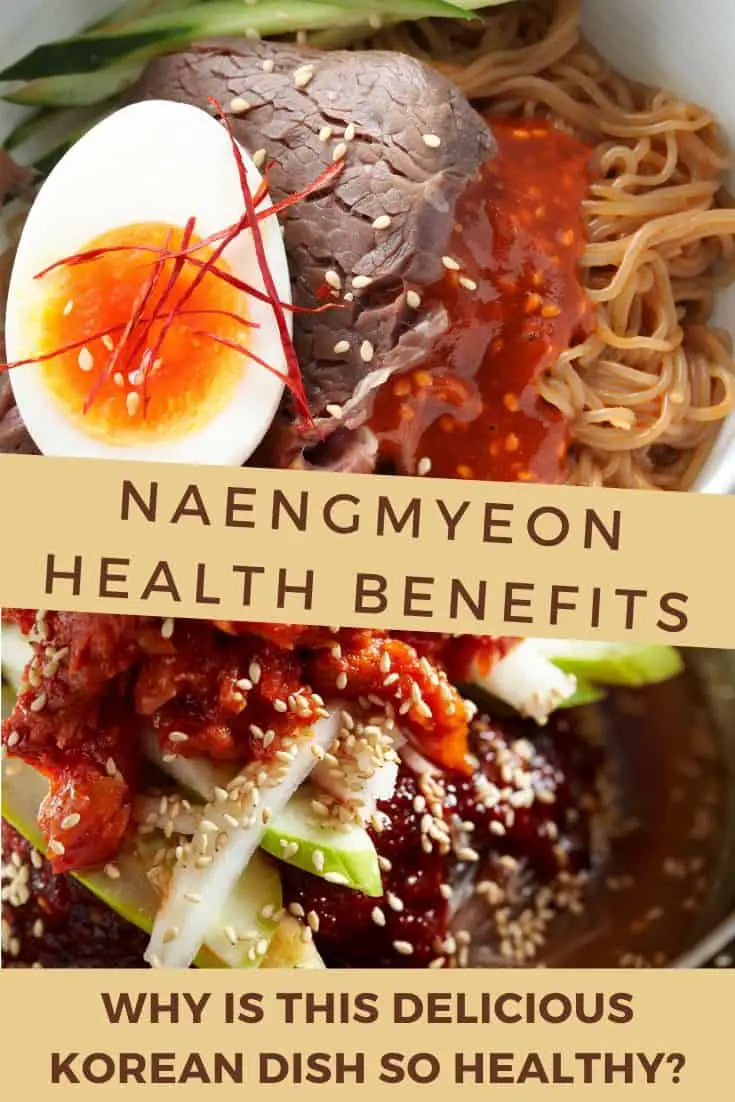

Check out our new cookbook
Bitemybun's family recipes with complete meal planner and recipe guide.
Try it out for free with Kindle Unlimited:
Read for freeIn this post we'll cover:
What is naengmyeon?
Naengmyeon (or raengmyon) is a traditional Korean dish that’s popular in North Korea and South Korea.
“Naengmyeon” means “cold noodles,” and it’s actually a bowl of cold noodles in a chilled broth.
Usually, this dish is enjoyed during hot summer days because it’s cold and refreshing.
It’s kind of like enjoying a cold drink, except it’s an actual main course and has numerous health benefits! You’ll feel full and load your tummy with tasty fiber.
The noodles are usually made of buckwheat, potato starch, or sweet potato starch.
The idea behind this dish is that it’s something like a cold soup, with chilled noodles, cold broth, or spicy sauce.
You can add different ingredients to the broth, but there are a few basic ingredients every bowl of naengmyeon must contain.
Main ingredients:
- Noodles
- Broth (beef) or spicy sauce
- Pickled radish (kimchi)
- Cucumber
- Egg
- Asian pear
Some recipes add meat (usually beef or chicken), but that’s optional.
One of the reasons that this dish is so healthy and low in calories is because it doesn’t contain many ingredients; it’s simple, but tasty!
Here’s Maangchi with a great recipe video:
What’s the healthiest naengmyeon?
Did you know that the North Korean version (called mul, or Pyongyang naengmyeon) is considered the healthiest option?
Many South Koreans fell in love with this dish after it became popular during a summit between the North and South.
After this dish was mediatized and popularized, it started a whole craze where people lined up for hours to get a taste.
And do you know why it became popular? Because it was touted and advertised as nutritious and diet-friendly!
Well, you can’t blame them because I’ll explain to you how the nutrients in this dish help your body.
Pyongyang naengmyeon is made of cold buckwheat noodles, beef broth, and garnished with delicious dongchimi, which is a radish water kimchi.
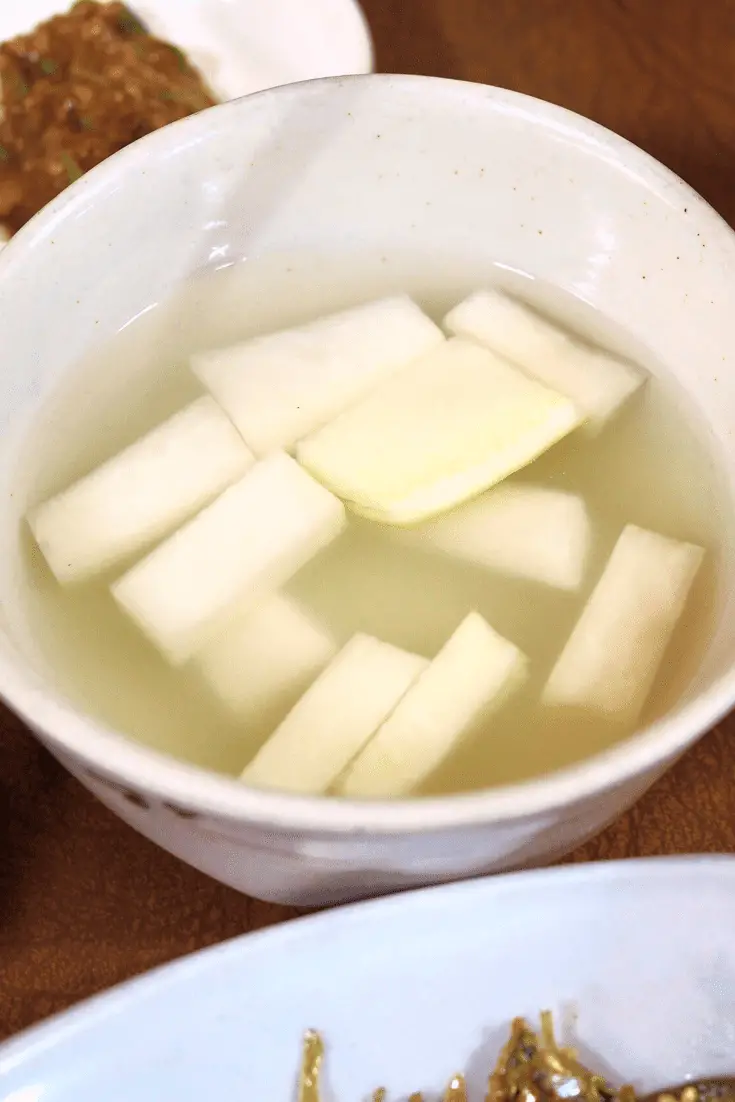
The second type of this dish is called bibim naengmyeon, and it’s cold noodles served with a spicy chilled red chili sauce instead of broth.
The noodles in this dish are harder and chewier because they’re made of potato and sweet potato starch.
This dish has a higher sodium content, about 720 mg because of the spicy sauce.
Did you know spicy chili sauce is healthy for you though? This is because it contains capsaicin, which is an active ingredient found in pepper.
It has anti-inflammatory properties and acts as an antioxidant. And several lab studies have shown it has anti-cancer properties!
Does naengmyeon help with weight loss?
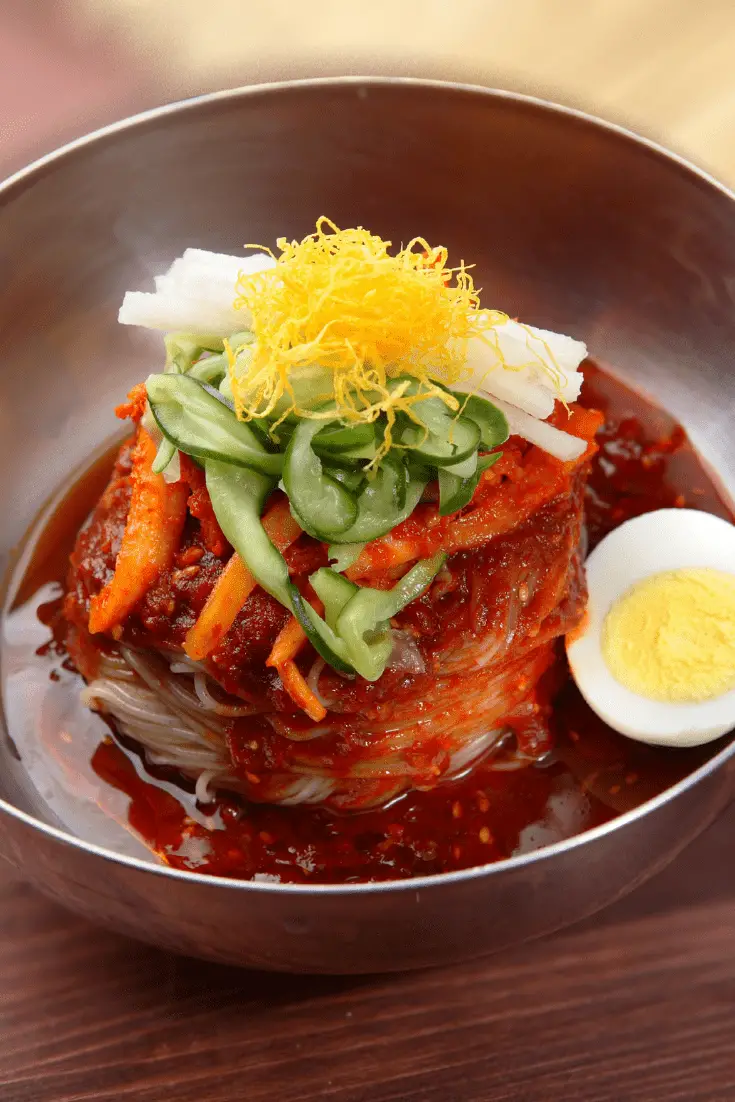
The spiciness adds flavor to the dish without adding many calories. While you’re eating the spicy food, your sinuses are being decongested, so yes, it’s okay to get teary-eyed.
Another benefit of capsaicin is that it boosts your metabolism, helping you burn more fat.
Spicy foods generally don’t let you overeat because you just can’t eat that much, so you’ll end up eating a healthy portion of food. It’s an excellent aid for weight loss, and it’s one of the reasons people love to eat the bibim version of naengmyeon.
Calories
The number of calories that this dish has depends on the ingredients it’s made of. So I’m going to list the number of calories and nutritional information for a basic bowl of naengmyeon.
Most bowls of traditional naengmyeon have approximately 500 calories.
Let’s pretend you eat a bowl of this yummy food; you’ll be consuming approximately:
- 490 calories
- About 75 grams of carbs
- 10 grams of fat
- And 18 grams of protein
This isn’t considered a high-calorie or high-fat food.
Just imagine that in a glass of red wine, you’re consuming about 130 calories, and it’s not food! In a breakfast where you eat granola, yogurt, and nuts, you’re eating about 700 calories!
Naengmyeon is a meal, a filling lunch, or dinner dish.
To burn off this food, you’ll have to do about an hour of running or an hour of cycling.
Health benefits of naengmyeon
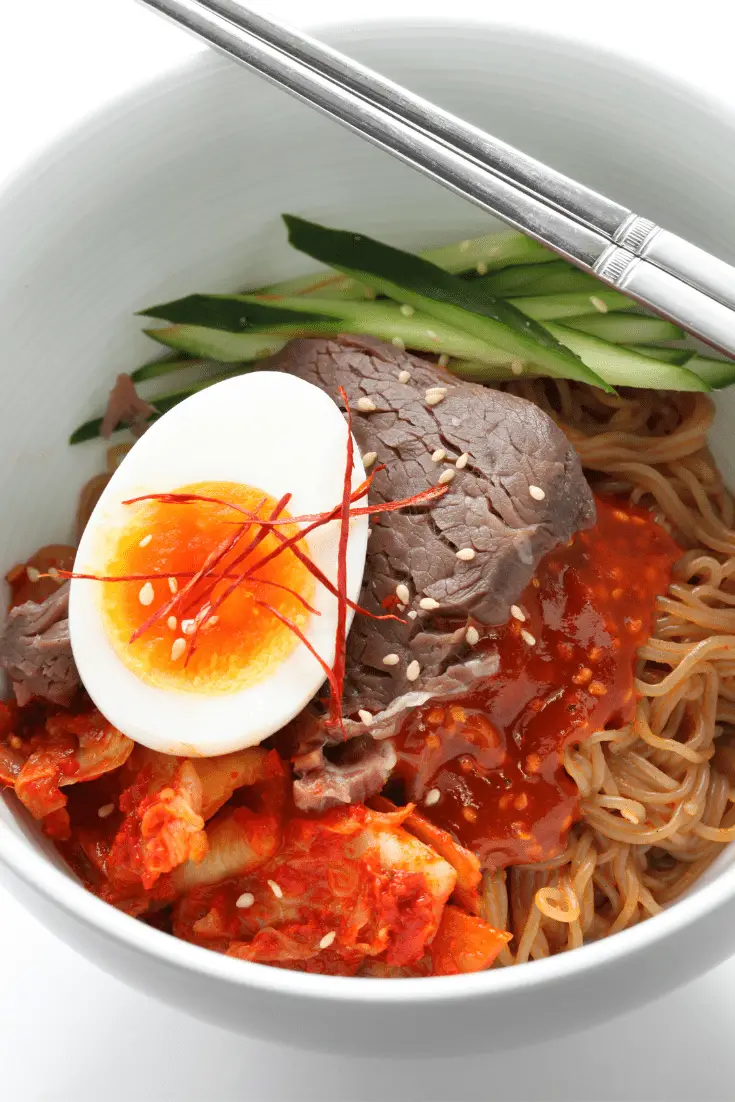
You’re probably wondering, why do people eat this dish so often? Well, because it’s healthy!
To understand the health benefits, we need to take a closer look at all the ingredients individually to see why each one is healthy and why this combination of ingredients makes for a healthy dish.
The nutritional value is the term used to refer to the contents of food and what the impact of these constituents is on the human body.
You’ll see nutritional values on all food item labels. This “value” breaks down how many calories a food has, how much fat, how many carbs, salt, sugar, etc.
A typical dish of naengmyeon has approximately:
- 75 grams of carbs
- 9 grams of fat
- 17 grams of protein
- 2 grams of sugar
- 1500 mg of sodium
- 189 mg of cholesterol
This Korean dish has a high nutritional value because all of the ingredients in the food contain beneficial vitamins and minerals.
Now, let’s discuss the health benefits based on each main ingredient.
Noodles of naengmyeon
Noodles can be made of:
- Buckwheat: These noodles are low fat, gluten-free, and high in protein. They contain manganese, which is a mineral that helps the metabolism to break down cholesterol and carbs. Buckwheat also contains thiamin, which is known as vitamin B1; it helps the body turn carbs into energy. This vitamin plays a vital role in the nervous system.
- Potato starch: This starch acts like fiber, which is healthy for the digestive tract. It helps to lower blood sugar levels in the body. It can also aid weight loss by keeping insulin under control and reducing the level of serum in cholesterol.
- Sweet potato starch: This type of starch helps with weight loss because it reduces your appetite. It helps lower blood sugar levels and improves insulin sensitivity. The starch made from sweet potato acts like a fiber and helps the body because it’s resistant to starch.
- Arrowroot starch: This isn’t a grain; it’s a gluten-free starch option. This type of carbohydrate is easily digested. Arrowroot is a source of potassium, iron, and B vitamins. These contribute to a healthy metabolism, improved blood circulation, and a healthy heart. This plant also boosts your immune system and helps cells grow.
- Kuzu: This is Japanese arrowroot; kuzu is the starch made from this root. Kuzu helps to relieve allergy symptoms, such as sneezing. It’s also healthy because it’s a great natural anti-inflammatory. It also lowers cholesterol and lowers blood pressure. Did you know it even has anti-cancer properties?
Toppings of naengmyeon
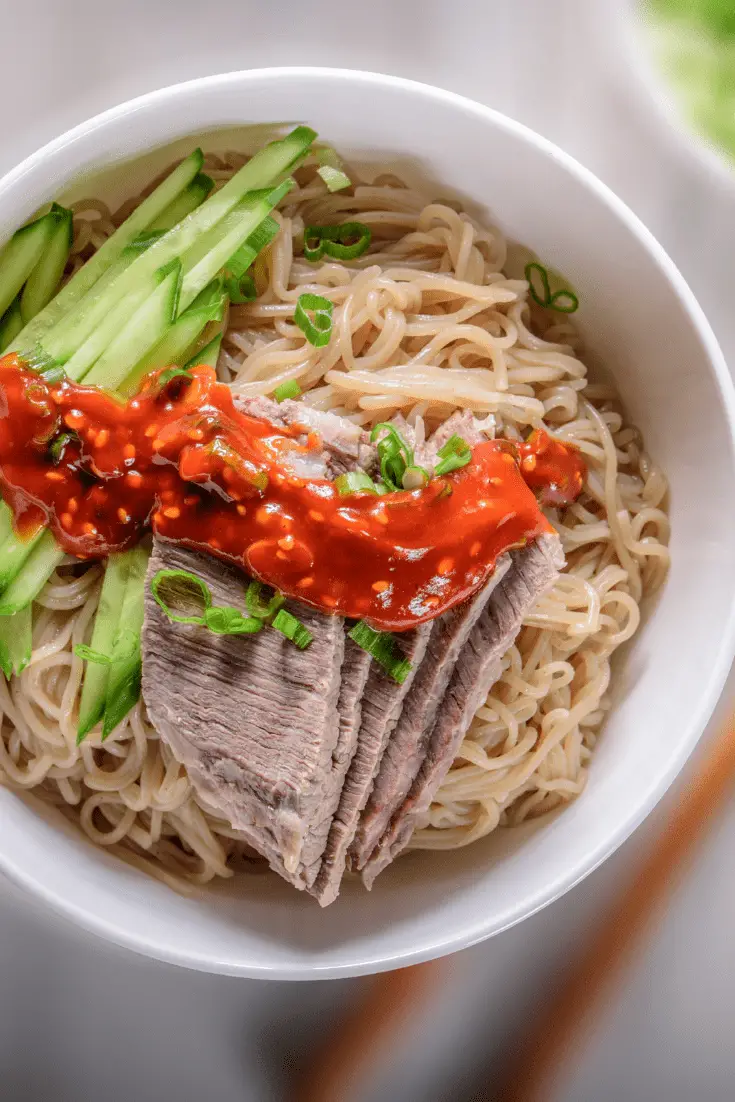
There are several “topping” ingredients used to garnish the noodles and broth. Let’s examine why they’re healthy!
Naengmyeon contains dongchimi, kimchi made with radish water. Have you heard about all the health benefits of kimchi?
Kimchi is a great food to add to your meals. It’s full of nutrients, yet is considered a low-calorie food.
Since kimchi is fermented, it contains healthy probiotics, known as good gut bacteria.
As well, it’s believed that kimchi contributes to a healthy heart and reduces the chances of yeast infections, especially in women.
Koreans have been using kimchi to strengthen their immune system and slow the aging process.
It’s no wonder why kimchi is used in so many Asian dishes, and it’s an essential ingredient for naengmyeon!
Another ingredient you’ll find in naengmyeon is Asian pear, or Nashi pears. This fruit is native to Asia and is similar in shape to an apple.
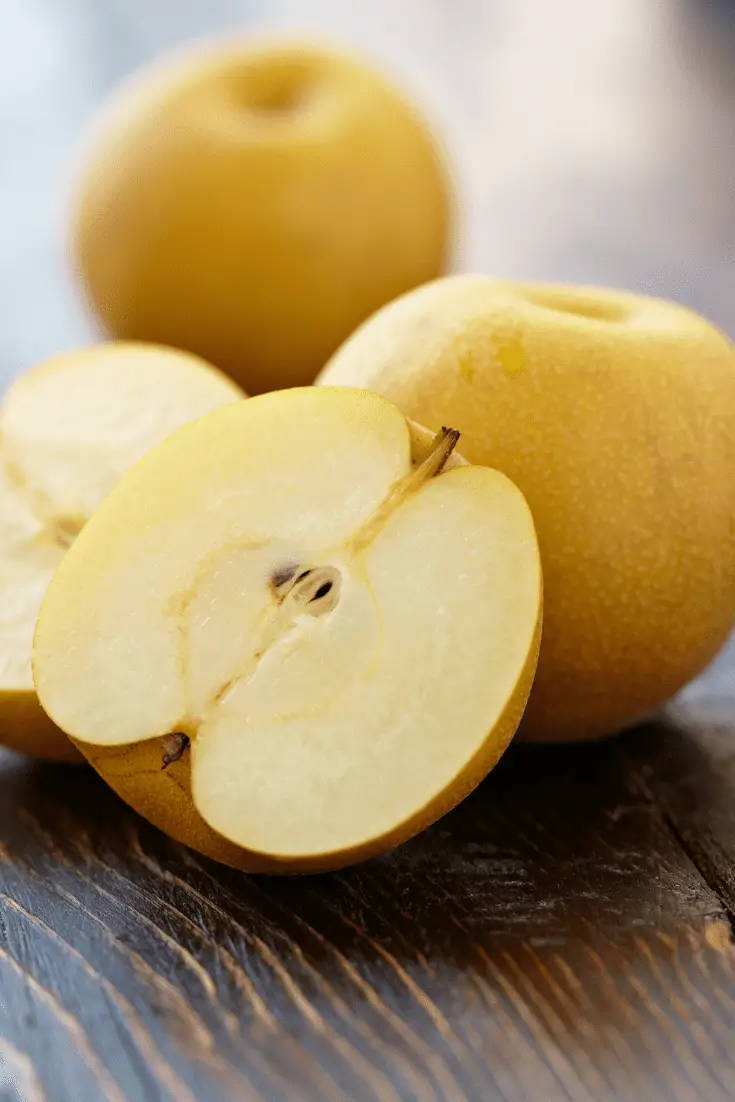
It’s an excellent source of dietary fiber, can aid digestion, and help your colon function properly.
These pears also support your bones, heart, and help improve blood circulation. They’re a source of vitamin C, vitamin K, and potassium.
This dish contains 1 egg. Eggs are an excellent source of protein and contain vitamin B2, which helps the body break down protein, fat, and carbs.
Eggs also contain essential minerals such as zinc, copper, and iron. They’re also high in vitamin D, which helps your body absorb calcium and contributes to healthy bones.
Can’t find Asian pears? Here are the best substitutes for Nashi that you can use instead
Cool down with some naengmyeon
I think we can agree that naengmyeon is a healthy food option if you want a delicious low-calorie Korean dish!
Consumers are increasingly interested in healthy food options, and restaurants are constantly evolving and improving their naengmyeon recipes.
Recently, many have started to reduce the sodium content of their noodles.
For those searching for even fewer calories, there’s a brand called “Beauty Calorie Noodle”, which makes cold noodles that come in at just 160 kcal per portion!
So there’s something for all diets and all tastes out there. All you have to do is try naengmyeon, and you’ll be sure to love it!
Check out our new cookbook
Bitemybun's family recipes with complete meal planner and recipe guide.
Try it out for free with Kindle Unlimited:
Read for freeJoost Nusselder, the founder of Bite My Bun is a content marketer, dad and loves trying out new food with Japanese food at the heart of his passion, and together with his team he's been creating in-depth blog articles since 2016 to help loyal readers with recipes and cooking tips.

